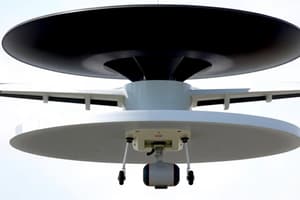Podcast
Questions and Answers
The localizer carrier frequencies range from ______ MHz to ______ MHz.
The localizer carrier frequencies range from ______ MHz to ______ MHz.
108.10, 111.95
What is the amplitude of the 90 Hz modulation in the localizer signal?
What is the amplitude of the 90 Hz modulation in the localizer signal?
- Variable, depending on the aircraft's position (correct)
- 75 µAmps
- 150 µAmps
- 90 µAmps
The glideslope transmitter emits a 90 Hz and 150 Hz modulated signal.
The glideslope transmitter emits a 90 Hz and 150 Hz modulated signal.
True (A)
What is the primary function of the localizer system?
What is the primary function of the localizer system?
A 1º deviation in the localizer signal corresponds to a ______ µAmps receiver output.
A 1º deviation in the localizer signal corresponds to a ______ µAmps receiver output.
Which of the following is NOT a component of the ILS system?
Which of the following is NOT a component of the ILS system?
What are the two harmonics generated by combining a 90 Hz and 150 Hz signal?
What are the two harmonics generated by combining a 90 Hz and 150 Hz signal?
Match the ILS components with their functions:
Match the ILS components with their functions:
The glideslope coverage sector extends 25 nm from the runway centerline.
The glideslope coverage sector extends 25 nm from the runway centerline.
Calculate the rate of descent required for an aircraft with a ground speed of 120 knots on a 3º glideslope.
Calculate the rate of descent required for an aircraft with a ground speed of 120 knots on a 3º glideslope.
What is the frequency of the carrier wave used for station identification?
What is the frequency of the carrier wave used for station identification?
The phase difference from the reference signal indicates the speed of the aircraft.
The phase difference from the reference signal indicates the speed of the aircraft.
What communication method is used for station identification in this system?
What communication method is used for station identification in this system?
The identification signal consists of three Morse letters transmitted at a rate of about _____ words per minute.
The identification signal consists of three Morse letters transmitted at a rate of about _____ words per minute.
Match the following components with their descriptions:
Match the following components with their descriptions:
What is displayed on the Omni Bearing Selector (OBS)?
What is displayed on the Omni Bearing Selector (OBS)?
VOR stations are primarily located at random locations without specific positioning along airways.
VOR stations are primarily located at random locations without specific positioning along airways.
What type of antennas are most suitable for VOR navigational receivers?
What type of antennas are most suitable for VOR navigational receivers?
The pilot can select the radial he wishes to fly on the __________ as an intended track.
The pilot can select the radial he wishes to fly on the __________ as an intended track.
Match the VOR component with its description:
Match the VOR component with its description:
What is the primary function of the phase comparator in a VOR system?
What is the primary function of the phase comparator in a VOR system?
A warning flag will appear on the VOR instrument if there is a weak signal from either the reference or variable signal.
A warning flag will appear on the VOR instrument if there is a weak signal from either the reference or variable signal.
What does the TO-FROM indication on the VOR system indicate?
What does the TO-FROM indication on the VOR system indicate?
The accuracy of the VOR indication will be within ___ for 95% of the time when all errors are combined.
The accuracy of the VOR indication will be within ___ for 95% of the time when all errors are combined.
Match the following VOR indicators to their meanings:
Match the following VOR indicators to their meanings:
What is the purpose of the deviation instrumentation circuit in the ILS system?
What is the purpose of the deviation instrumentation circuit in the ILS system?
The glideslope receiver operates on the same frequency band as the localizer receiver.
The glideslope receiver operates on the same frequency band as the localizer receiver.
What happens to the ILS system when its monitoring and self-checking system fails?
What happens to the ILS system when its monitoring and self-checking system fails?
The ___ is applied to drive the vertical deviation course pointers.
The ___ is applied to drive the vertical deviation course pointers.
Match the following components of the ILS system with their functions:
Match the following components of the ILS system with their functions:
What frequency band does the VHF Omni Range (VOR) system operate in?
What frequency band does the VHF Omni Range (VOR) system operate in?
VOR suffers from night effect, which limits its usability.
VOR suffers from night effect, which limits its usability.
What is the maximum number of tracks that the VOR system can produce?
What is the maximum number of tracks that the VOR system can produce?
The VOR system provides an infinite number of ______ from a beacon.
The VOR system provides an infinite number of ______ from a beacon.
Match the components of the VOR system with their descriptions:
Match the components of the VOR system with their descriptions:
Which statement best describes the VOR system?
Which statement best describes the VOR system?
The VOR system is less reliable than other directional systems.
The VOR system is less reliable than other directional systems.
In the analogy provided for the VOR system, what does the lighthouse represent?
In the analogy provided for the VOR system, what does the lighthouse represent?
Flashcards
VOR Frequency Spectrum
VOR Frequency Spectrum
The range of frequencies used in VOR systems, displaying 30 Hz signals.
Transmitter Phase Relationship
Transmitter Phase Relationship
The transmitter's signals are in phase at magnetic north, changing with bearing.
Phase Difference
Phase Difference
The difference in phase between variable and reference signals indicates aircraft bearing.
Station Identification
Station Identification
Signup and view all the flashcards
ICAO Recommendations
ICAO Recommendations
Signup and view all the flashcards
Intermediate Frequency (IF) signal
Intermediate Frequency (IF) signal
Signup and view all the flashcards
Δ signal
Δ signal
Signup and view all the flashcards
Attitude Director Indicator
Attitude Director Indicator
Signup and view all the flashcards
Glideslope Receiver
Glideslope Receiver
Signup and view all the flashcards
Monitoring System
Monitoring System
Signup and view all the flashcards
VOR Indicators
VOR Indicators
Signup and view all the flashcards
Airway Centreline
Airway Centreline
Signup and view all the flashcards
Bat-Wing Antennas
Bat-Wing Antennas
Signup and view all the flashcards
VHF Band
VHF Band
Signup and view all the flashcards
OBS (Omni Bearing Selector)
OBS (Omni Bearing Selector)
Signup and view all the flashcards
Harmonics
Harmonics
Signup and view all the flashcards
90 Hz Tone
90 Hz Tone
Signup and view all the flashcards
150 Hz Tone
150 Hz Tone
Signup and view all the flashcards
Localizer Carrier Frequency
Localizer Carrier Frequency
Signup and view all the flashcards
Glideslope Carrier Frequency
Glideslope Carrier Frequency
Signup and view all the flashcards
Localizer Deviation
Localizer Deviation
Signup and view all the flashcards
Glideslope Deviation
Glideslope Deviation
Signup and view all the flashcards
Rate of Descent
Rate of Descent
Signup and view all the flashcards
ILS
ILS
Signup and view all the flashcards
Ground Speed
Ground Speed
Signup and view all the flashcards
VHF Omni Range (VOR)
VHF Omni Range (VOR)
Signup and view all the flashcards
VOR Frequency Band
VOR Frequency Band
Signup and view all the flashcards
Radials
Radials
Signup and view all the flashcards
VOR Beacon
VOR Beacon
Signup and view all the flashcards
Static-Free Operation
Static-Free Operation
Signup and view all the flashcards
Localizer Frequency
Localizer Frequency
Signup and view all the flashcards
Wavelength Analogy
Wavelength Analogy
Signup and view all the flashcards
Glideslope Detection
Glideslope Detection
Signup and view all the flashcards
VOR Audio Signal Processing
VOR Audio Signal Processing
Signup and view all the flashcards
Phase Comparator Function
Phase Comparator Function
Signup and view all the flashcards
Sync Format Voltage Conversion
Sync Format Voltage Conversion
Signup and view all the flashcards
Course Deviation Indication
Course Deviation Indication
Signup and view all the flashcards
VOR Warning Flag
VOR Warning Flag
Signup and view all the flashcards
Study Notes
Instrument Landing System (ILS) & VHF Omni Range System (VOR)
- ILS Introduction: ILS provides precision guidance for aircraft landing, developed after World War II.
- ILS Working Principle: Uses a pair of antennas (localizer and glideslope) to transmit beams directing the aircraft towards the runway's center line with a set descent rate.
- ILS Categories: ICAO defines three categories of runway visibility (RVR) for ILS approach.
- Category I: 800m (2600ft)
- Category II: 400m (1200ft)
- Category III: 200m (700ft)
Localizer
- Frequency Band: 108.10 to 111.95 MHz, with 50 kHz spacing.
- Beams: Two directional beams (left and right). modulated with 90 Hz and 150 Hz signals.
- Indicator Deflection: 90 Hz signal dominates if the aircraft is to the left of the runway centerline, deflecting the indicator to the right. 150 Hz signal dominates if the aircraft is right of the runway, the indicator deflects left.
- Coverage: Within 10 degrees of runway centerline for 25 nm. within 35 degrees of runway for 17 nm.
Glideslope
- Frequency Band: 329.5 to 335.0 MHz, with 150 kHz spacing.
- Beam Orientation: Two directional beams (above each other)
- Modulation: Upper beam: 90 Hz ; Lower beam: 150 Hz
- Indicator Direction: If aircraft is above the glideslope, the 90 Hz signal dominates, indicating the glideslope is below the aircraft, the indicator deflects down. If the aircraft is below the glideslope, the 150 Hz signal dominates, causing the indicator to deflect up.
- Coverage: Within 1.35° to 5.25° vertical angles for 10nm
Studying That Suits You
Use AI to generate personalized quizzes and flashcards to suit your learning preferences.


